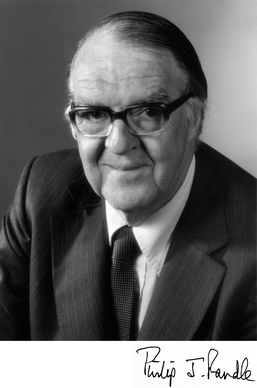Philip Randle facts for kids
Sir Philip John Randle (born July 16, 1926 – died September 26, 2006) was an important British medical researcher. He is known for discovering the Randle cycle, which helps us understand how our bodies use energy.
Contents
Early Life and Education
Philip Randle was born on July 16, 1926, in Nuneaton, England. He went to King Edward VI Grammar School in his hometown. After school, he studied science at Sidney Sussex College, Cambridge, where he earned top honors.
He then went on to study medicine at University College Hospital and the UCL Medical School. He became a medical doctor. After this, he returned to the University of Cambridge to work on his Ph.D. His research focused on how insulin affects the body's metabolism. He finished his Ph.D. in 1955 and soon became a lecturer in biochemistry at the university.
Career and Achievements
In 1964, Philip Randle became the first Professor of Biochemistry at the University of Bristol. He built a strong research team there. His team studied how cells move things around and how proteins work. They also looked at how mammals use energy.
In 1975, he moved to the University of Oxford. There, he became a founding professor and chairman of the Department of Clinical Biochemistry. He held this important position until 1993.
Sir Philip received many honors for his work. He was elected a Fellow of the Royal Society in 1983. This is a very high honor for scientists in the UK. He also served as the President of the Biochemical Society from 1995 to 2000. In 1975, he was knighted, which is why he is called "Sir Philip."
Understanding the Randle Cycle
Sir Philip Randle was a leading researcher in diabetes mellitus. He is most famous for describing the Randle cycle. This cycle explains how our bodies decide whether to use carbohydrates (like sugars) or fats for energy.
His research showed that our heart and muscle cells can switch between these two fuel sources. The Randle Cycle explains that when our bodies use more fat for energy, it can reduce how much glucose (sugar) our cells use. This allows people to switch between fuels depending on what they eat.
This research also suggested a possible way that hyperglycemia (high blood sugar) and type 2 diabetes might develop. He studied people on low-carbohydrate diets and those with non-insulin-dependent diabetes. His findings supported his idea. They suggested that too much release of fatty acids in muscle tissue could be a key factor in diabetes.
Scientists are still studying the Randle Cycle today. It continues to be an important area of research.
Personal Life
Sir Philip Randle was married to Elizabeth Harrison, who passed away in 2004. They had a son named Peter and three daughters: Susan, Sally, and Rosalind.
Images for kids



